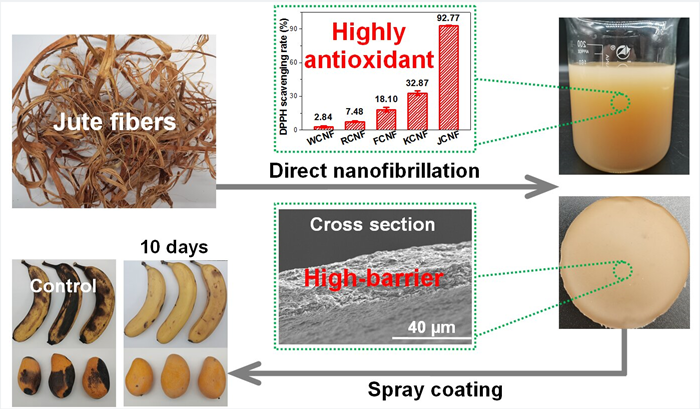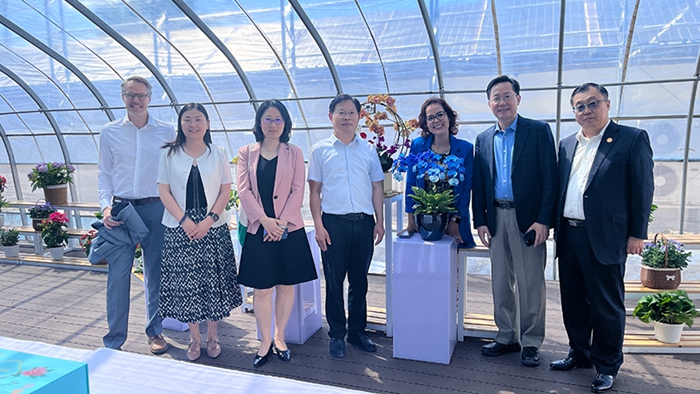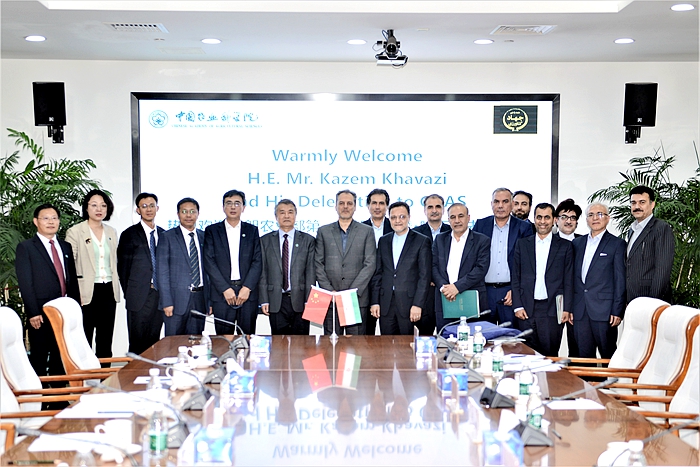Sustainable Cellulose Nanofibril Composite Films from Jute Fibers as Sprayable Coatings for Fruit Preservation
Recently, researchers from Institute of Bast Fiber Crops of Chinese Academy of Agricultural Sciences, Hunan Agricultural University, East China University of Science and Technology, and University of Waterloo (Canada) have developed a jute-derived cellulose nanofibril coating for fruit preservation, which significantly prolonged the shelf life of bananas and mangos (about 5 days). This study pioneers the preparation of sustainable active packaging materials directly from natural biomass, boosting related applications in food and farming systems.
Nowadays, more than 800 million people are under-nourished, while one third of all food produced globally is wasted. This is mainly due to perishable foods expiring quickly during their distribution from the farm to home. Petroleum-based plastics are the most widely used materials for food packaging owing to their exceptional barrier and mechanical properties. But the plastic pollution has become a serious threat to natural ecosystems and human health. There is a critical need to advance more sustainable and eco-friendly packaging materials and practices to increase the shelf life of perishable foods. In this context, the use of nanocellulose reinforced biopolymer composites have been suggested as a promising strategy for the development of sustainable food packaging.
In this study, we explored the use of four bast fibers to produce cellulose nanofibrils via ball milling and high-pressure homogenization to produce cellulose nanofibril suspensions that was spray-coated onto model fruits (e.g., banana and mango) for food preservation. Unlike other cellulose nanofibril coatings derived from ramie, flax, and kenaf fibers, jute derived cellulose nanofibril coating significantly prolonged the shelf-life of fruits, due to its improved homogeneity, higher oxygen and UV barrier properties, as well as higher antioxidant activity. This work provides a new strategy to prepare sustainable active packaging materials from natural biomass without chemical modification or additive, boosting related applications in the fields of food and agriculture.
The research was supported by the Youth Program of the National Natural Science Foundation of China, the Science and Technology Innovation Project of the Chinese Academy of Agricultural Sciences, and so on.
The study entitled “Active Food Packaging Composite Films from Bast Fibers-Derived Cellulose Nanofibrils” has been published online in ACS Sustainable Chemistry & Engineering and can be accessed through the following link: https://doi.org/10.1021/acssuschemeng.4c03117.

Fig. Preparation of jute-derived cellulose nanofibril coating and its application in fruit preservation
By Yuwang
yuwang@caas.cn
-
 Jun 18, 2024Visit by CGIAR Executive Director Ismahane Elouafi to the Institute of Vegetables and Flowers,CAAS
Jun 18, 2024Visit by CGIAR Executive Director Ismahane Elouafi to the Institute of Vegetables and Flowers,CAAS -
 May 29, 2024CAAS President Meets Deputy Director General of IAEA
May 29, 2024CAAS President Meets Deputy Director General of IAEA -
 May 29, 2024CAAS President Meets Chairman of the Understanding China Forum
May 29, 2024CAAS President Meets Chairman of the Understanding China Forum -
 May 29, 2024CAAS President Meets Greek Minister
May 29, 2024CAAS President Meets Greek Minister -
 May 29, 2024CAAS President Meets Iranian First Deputy Minister of Agriculture
May 29, 2024CAAS President Meets Iranian First Deputy Minister of Agriculture
